Orientation-Dependent Indentation Behaviour of Additively Manufactured FeCo Sample: A Quasi In-Situ Study
Abstract
:1. Introduction
2. Materials and Methods
2.1. Sample Preparation
2.2. Indentation
2.3. Microstructural Analysis
2.4. Laser Scanning Confocal Microscopy
2.5. Finite Element Method Simulations
3. Results
3.1. Finite Element Method Simulations
3.1.1. Effect of Building Height on Melt Pool Shape during LPBF
3.1.2. Effect of Laser Scan Speed on Melt Pool during LBPF
3.1.3. Indentation Geometry upon Vickers Hardness Testing
3.2. Microstructural Characterisation
4. Discussion
4.1. Quasi In-Situ Microstructural Analysis of Indentation 13
4.2. Topography of Indentation 13
4.3. Quasi In-Situ Microstructural Analysis of Indentation 7
4.4. Effect of Indentation within Grain 1 near Indentation 7
4.5. Indentation-Induced Slip Transfer in Grain 1 near Indentation 7
4.6. Effect of Indentation on Micro-Texture
5. Conclusions
- (1)
- FEM simulations show that as the building height increases from 0.001 m to 0.1 m, the melt pool shape changes from nearly circular to elliptical. The aspect ratio of the melt pool changes from 1.03 to 1.17. The melt pool shape depends on processing parameters, alloy composition and building height. This is due to the decrease in the heat dissipation capacity due to the stored residual heat from the previous build layers.
- (2)
- As the laser scan speed increases from 675 mm/s to 775 mm/s, the aspect ratio of the elliptical melt pool changes from 1.08 to 1.17. With the increase in laser scan speed, the time available for heat dissipation decreases. This leads to the increase in the aspect ratio of the elliptical melt pool.
- (3)
- FEM simulations of the Vickers indentation show a high-stress concentration (greater than 600 MPa) which is higher than the yield strength (314 MPa) of the FeCo alloy investigated. This is expected to result in a large plastic zone near the indentation.
- (4)
- Laser scanning confocal microscopy emphasises a pile-up near the indentation. Due to deformation accommodation in the <110>||BD-oriented grains, a pile-up is observed.
- (5)
- GROD analysis underlines the indentation-induced slip transfer in the neighbouring grains. A high GROD misorientation is observed in the neighbouring grain region adjacent to the indented grain due to deformation accommodation.
- (6)
- A high concentration of GNDs is observed in the area near the indentation due to misorientation (generated due to deformation accommodation).
- (7)
- On superimposing the direction of slip lines with slip traces, the activation of all the three slip systems ({110}<111>, {112}<111> and {123}<111>) is confirmed. This result is also verified by SEM images showing wavy slip lines. Hence, in grain 1 near indentation 7, multiple slip systems are activated.
- (8)
- Inverse pole figure maps highlight the weakening of the <110>||BD orientation and strengthening of the <015>||BD orientation. No change in the intensity of the [49]||BD orientation is detected. A minor change in the intensity of pre-existing orientations is detected upon indentation due to indentation-induced slip transfer in the neighbouring grains.
Supplementary Materials
Author Contributions
Funding
Institutional Review Board Statement
Informed Consent Statement
Data Availability Statement
Acknowledgments
Conflicts of Interest
References
- Babuska, T.F.; Wilson, M.A.; Johnson, K.L.; Whetten, S.R.; Curry, J.F.; Rodelas, J.M.; Atkinson, C.; Lu, P.; Chandross, M.; Krick, B.A.; et al. Achieving high strength and ductility in traditionally brittle soft magnetic intermetallics via additive manufacturing. Acta Mater. 2019, 180, 149–157. [Google Scholar] [CrossRef]
- Babuska, T.F.; Johnson, K.L.; Verdonik, T.; Subia, S.R.; Krick, B.A.; Susan, D.F.; Kustas, A.B. An additive manufacturing design approach to achieving high strength and ductility in traditionally brittle alloys via laser powder bed fusion. Addit. Manuf. 2020, 34, 101187. [Google Scholar] [CrossRef]
- Kustas, A.B.; Susan, D.F.; Johnson, K.L.; Whetten, S.R.; Rodriguez, M.A.; Dagel, D.J.; Michael, J.R.; Keicher, D.M.; Argibay, N. Characterization of the Fe-Co-1.5V soft ferromagnetic alloy processed by Laser Engineered Net Shaping (LENS). Addit. Manuf. 2018, 21, 41–52. [Google Scholar] [CrossRef]
- Chaudhary, V.; Sai Kiran Kumar Yadav, N.M.; Mantri, S.A.; Dasari, S.; Jagetia, A.; Ramanujan, R.V.; Banerjee, R. Additive manufacturing of functionally graded Co–Fe and Ni–Fe magnetic materials. J. Alloys Compd. 2020, 823, 153817. [Google Scholar] [CrossRef]
- Han, Y.; Ding, J.; Kong, F.L.; Inoue, A.; Zhu, S.L.; Wang, Z.; Shalaan, E.; Al-Marzouki, F. FeCo-based soft magnetic alloys with high Bs approaching 1.75 T and good bending ductility. J. Alloys Compd. 2017, 691, 364–368. [Google Scholar] [CrossRef]
- Urbanek, S.; Ponick, B.; Taube, A.; Hoyer, K.P.; Schaper, M.; Lammers, S.; Lieneke, T.; Zimmer, D. Additive Manufacturing of a Soft Magnetic Rotor Active Part and Shaft for a Permanent Magnet Synchronous Machine. In Proceedings of the 2018 IEEE Transportation and Electrification Conference and Expo, ITEC 2018, Long Beach, CA, USA, 13–15 June 2018; Institute of Electrical and Electronics Engineers, Inc.: Piscataway, NJ, USA, 2018; pp. 217–219. [Google Scholar]
- Suresh, K.S.; Kitashima, T.; Yamabe-Mitarai, Y. Effects of orientation on hardness, strain accumulation, and fracture. Mater. Sci. Eng. A 2014, 618, 335–344. [Google Scholar] [CrossRef]
- Gokhale, A.; Sarvesha, R.; Huang, E.W.; Lee, S.Y.; Prasad, R.; Singh, S.S.; Jain, J. Quantitative evaluation of grain boundary sliding and its dependence on orientation and temperature in pure Zn. Mater. Lett. 2019, 246, 24–27. [Google Scholar] [CrossRef]
- Sarvesha, R.; Gokhale, A.; Kumar, K.; Sharma, N.K.; Jain, J.; Singh, S.S. Effect of crystal orientation on indentation-induced deformation behavior of zinc. Mater. Sci. Eng. A 2020, 776, 139064. [Google Scholar] [CrossRef]
- Xia, W.; Dehm, G.; Brinckmann, S. Insight into indentation-induced plastic flow in austenitic stainless steel. J. Mater. Sci. 2020, 55, 9095–9108. [Google Scholar] [CrossRef]
- Xia, W.; Dehm, G.; Brinckmann, S. Unraveling indentation-induced slip steps in austenitic stainless steel. Mater. Des. 2019, 183, 108169. [Google Scholar] [CrossRef]
- Zameer Abbas, S.; Ahmad Khalid, F.; Zaigham, H. Indentation fracture toughness behavior of FeCo-based bulk metallic glass intrinsic composites. J. Non-Cryst. Solids 2017, 457, 86–92. [Google Scholar] [CrossRef]
- Zameer Abbas, S.; Ahmad Khalid, F.; Zaigham, H. Indentation and deformation behavior of FeCo-based bulk metallic glass alloys. Mater. Sci. Eng. A 2016, 654, 426–435. [Google Scholar] [CrossRef]
- Pramanik, S.; Tasche, L.; Hoyer, K.-P.P.; Schaper, M. Investigating the microstructure of an additively manufactured FeCo alloy: An electron microscopy study. Addit. Manuf. 2021, 46, 102087. [Google Scholar] [CrossRef]
- Hielscher, R.; Schaeben, H. A novel pole figure inversion method: Specification of the MTEX algorithm. J. Appl. Crystallogr. 2008, 41, 1024–1037. [Google Scholar] [CrossRef]
- Pantleon, W. Resolving the geometrically necessary dislocation content by conventional electron backscattering diffraction. Scr. Mater. 2008, 58, 994–997. [Google Scholar] [CrossRef]
- Pramanik, S.; Tasche, L.; Hoyer, K.-P.; Schaper, M. Correlation between Taylor model prediction and TEM-based microstructural investigations of quasi in-situ tensile deformation of additively manufactured FeCo alloy. J. Mater. Eng. Perform. 2021, 30, 8048–8056. [Google Scholar] [CrossRef]
- Cheng, B.; Lydon, J.; Cooper, K.; Cole, V.; Northrop, P.; Chou, K. Melt Pool Dimension Measurement in Selective Laser Melting Using Thermal Imaging. In Proceedings of the 28th Annual International Solid Freeform Fabrication Symposium—An Additive Manufacturing Conference, Austin, TX, USA, 14 August 2017. [Google Scholar]
- Tong, V.; Wielewski, E.; Britton, B. Characterisation of slip and twinning in high rate deformed zirconium with electron backscatter diffraction. arXiv 2018, arXiv:1803.00236. [Google Scholar]
- Tong, V.; Wielewski, E.; Britton, B. Understanding plasticity in zirconium using in-situ measurement of lattice rotations. arXiv 2019, arXiv:1910.04187. [Google Scholar]
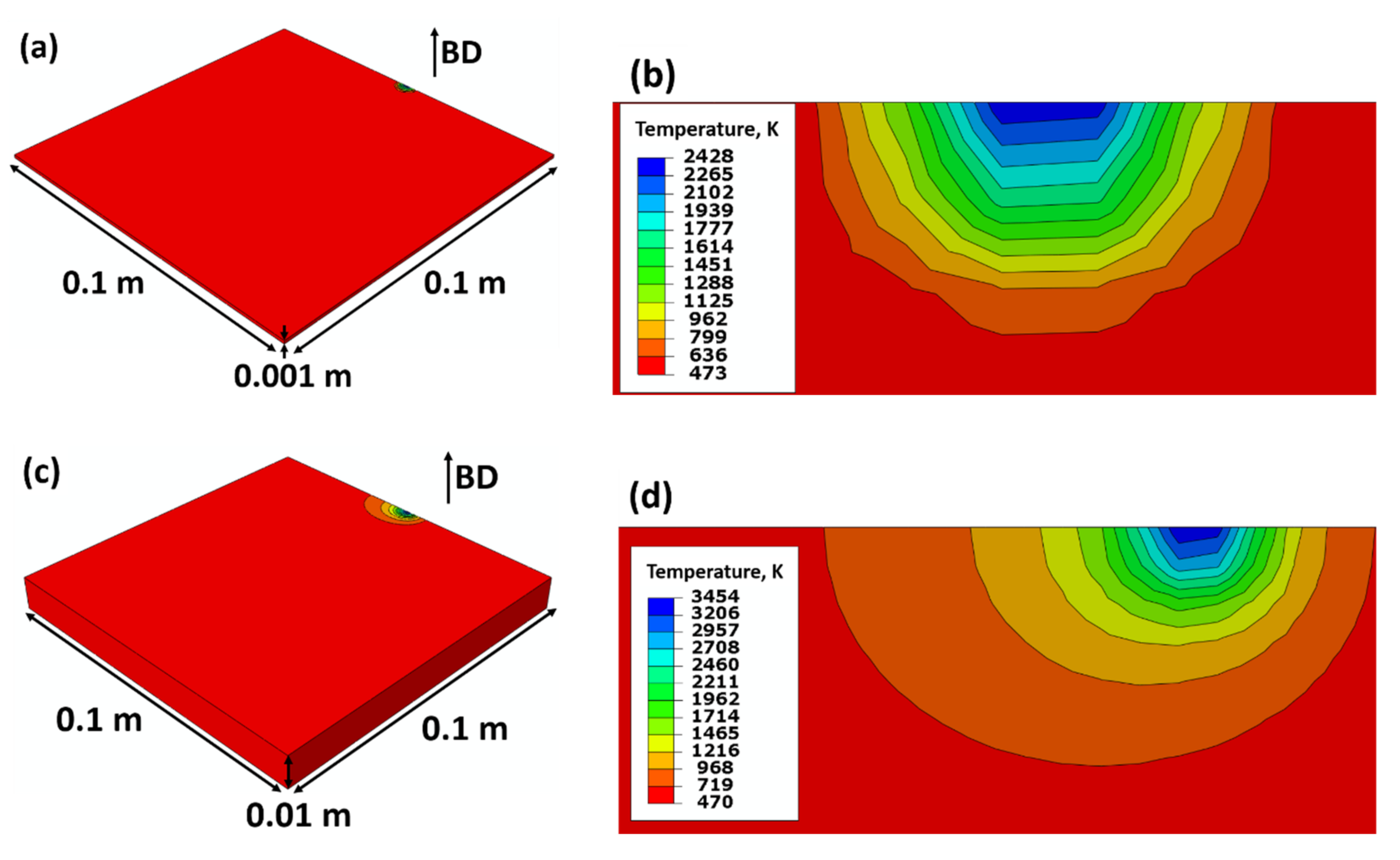
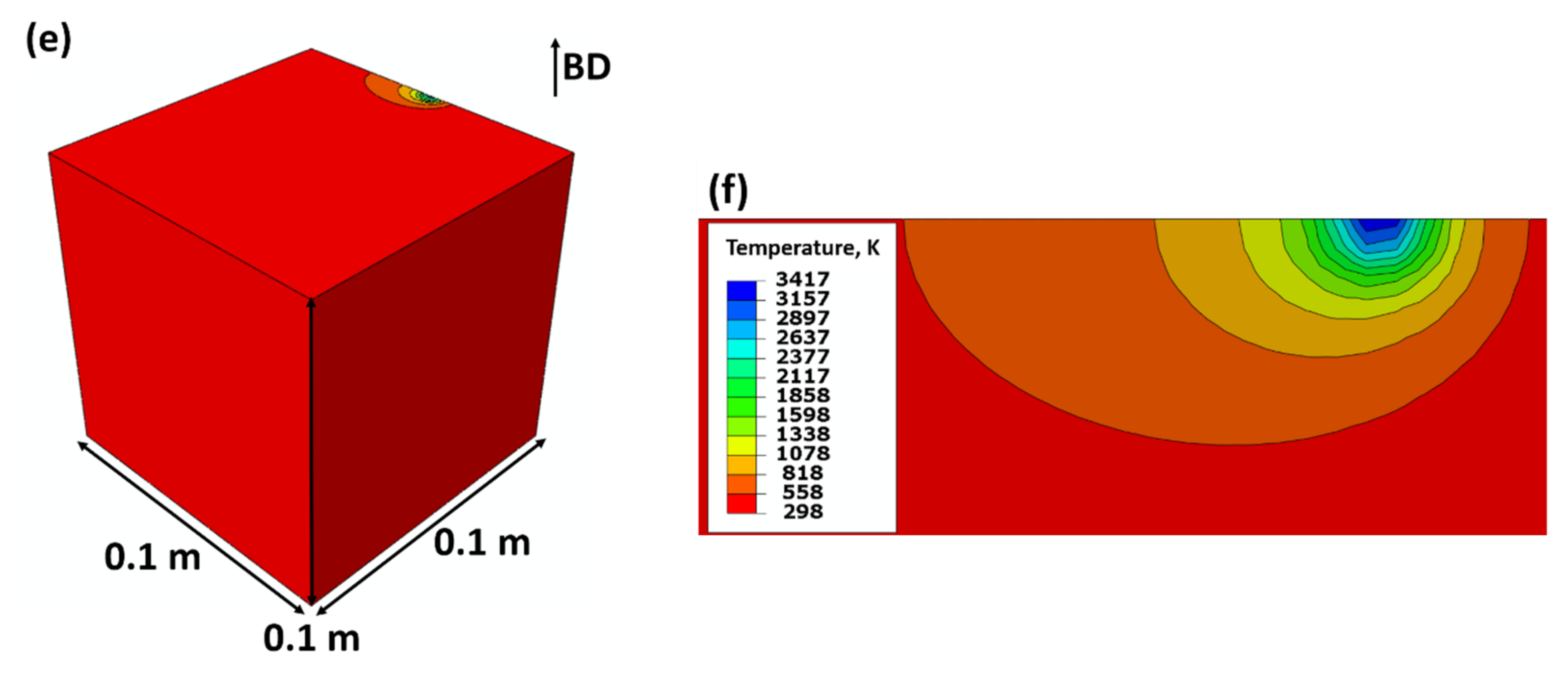


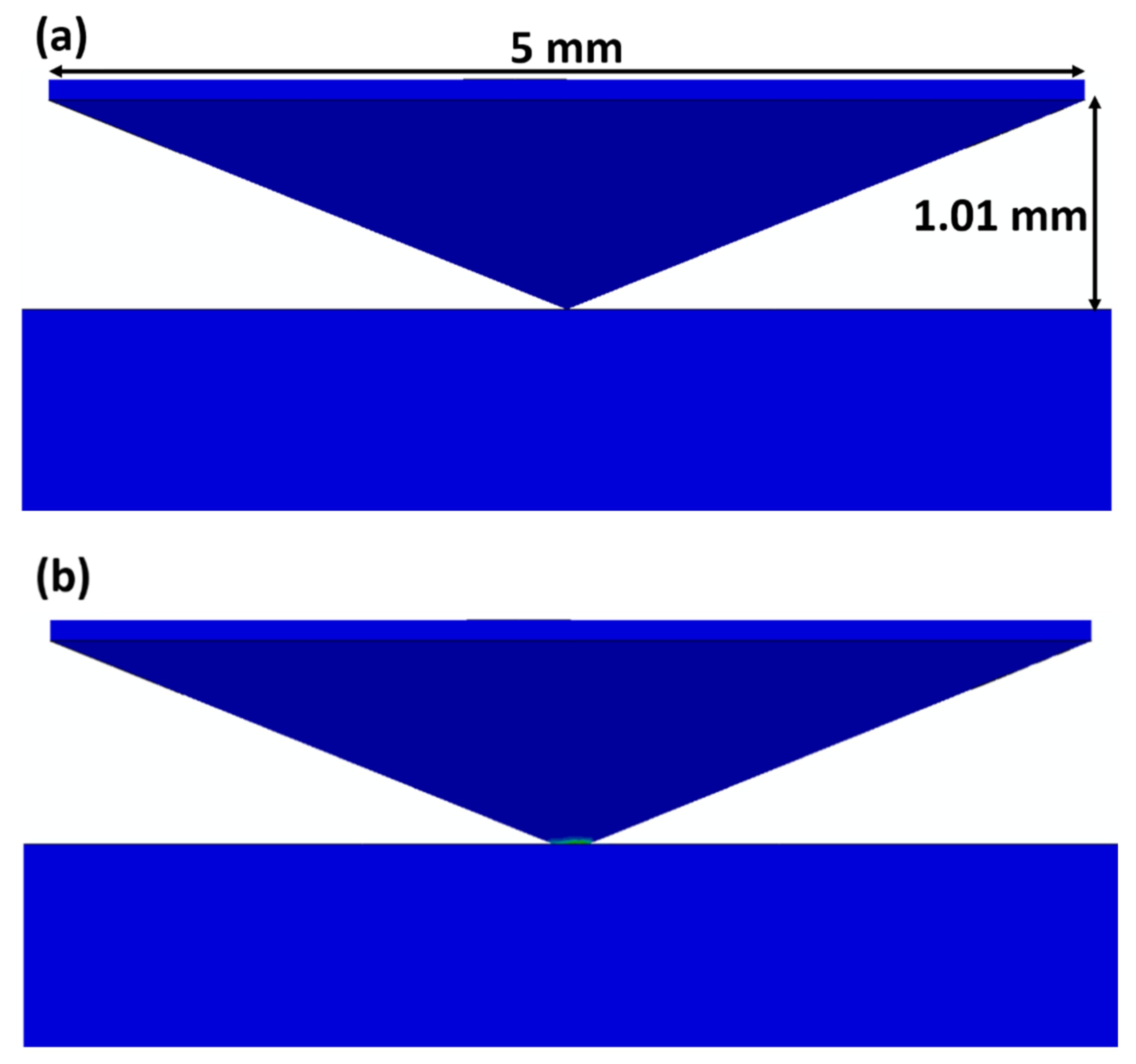



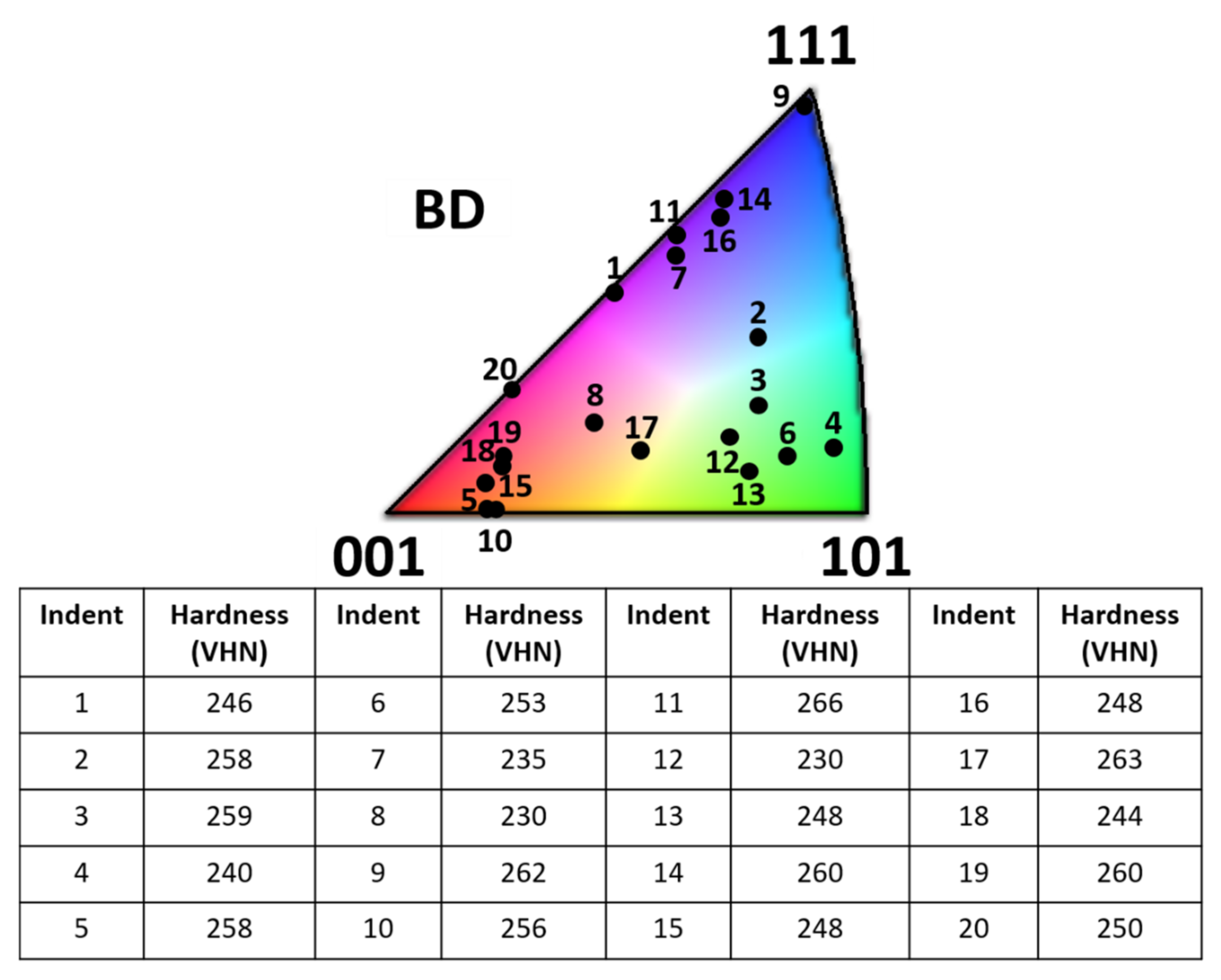

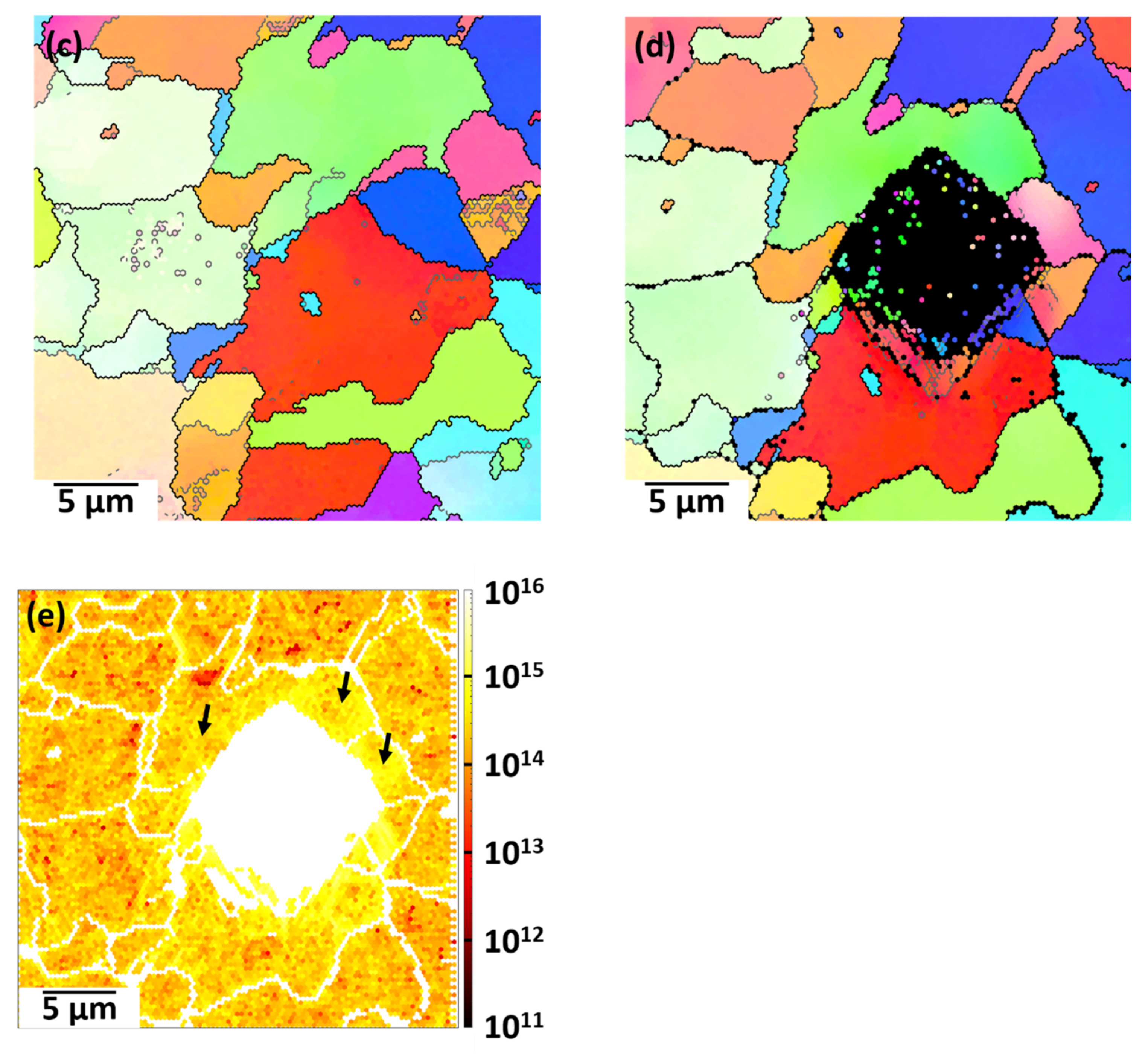
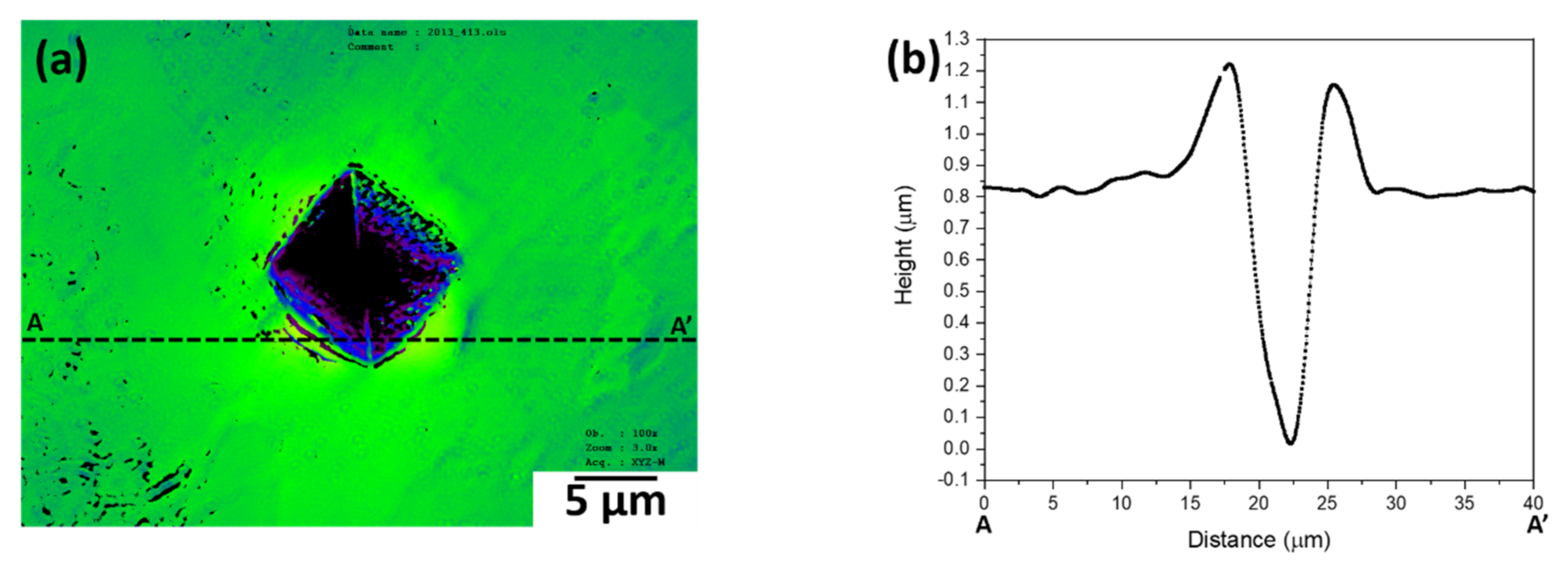
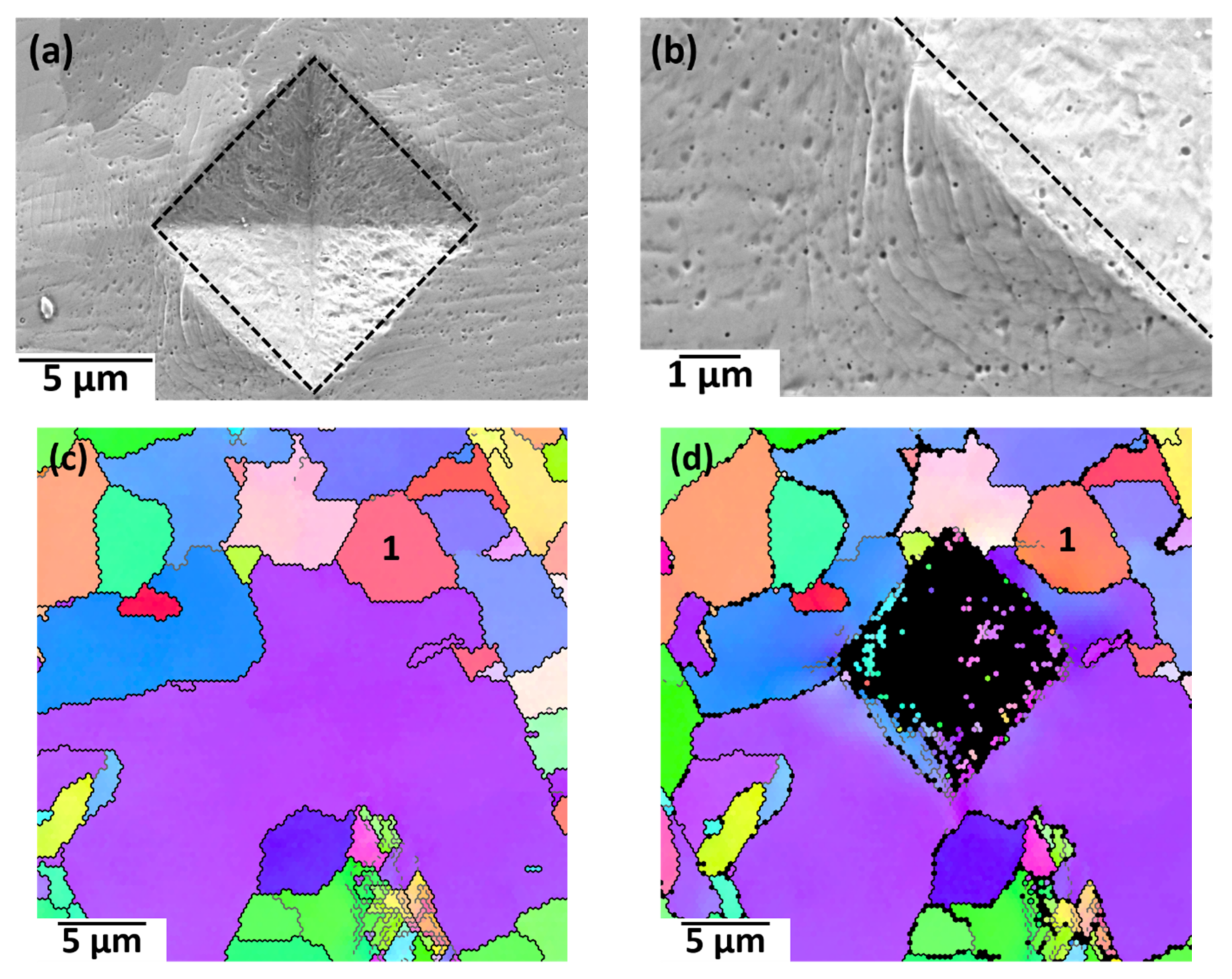
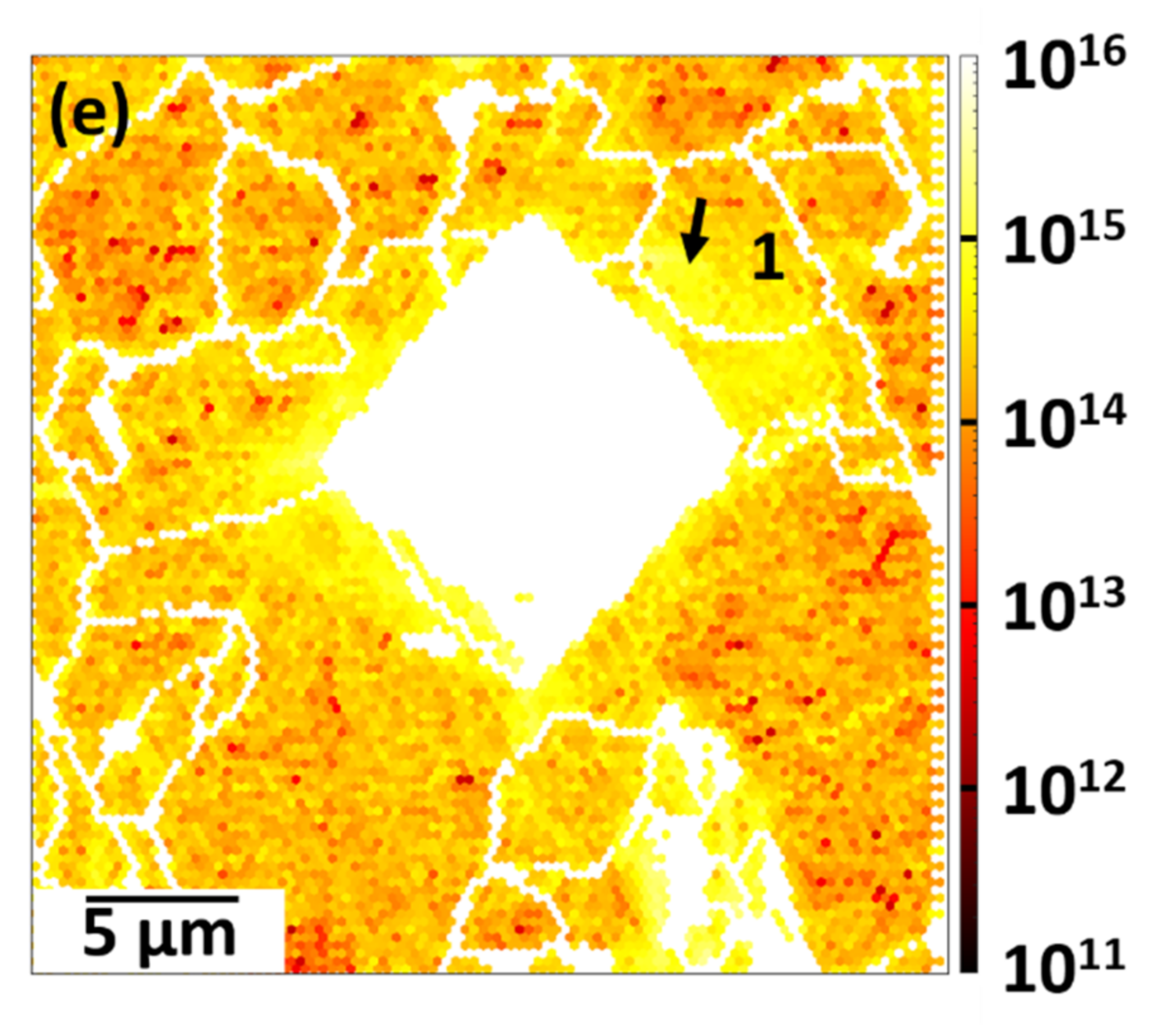
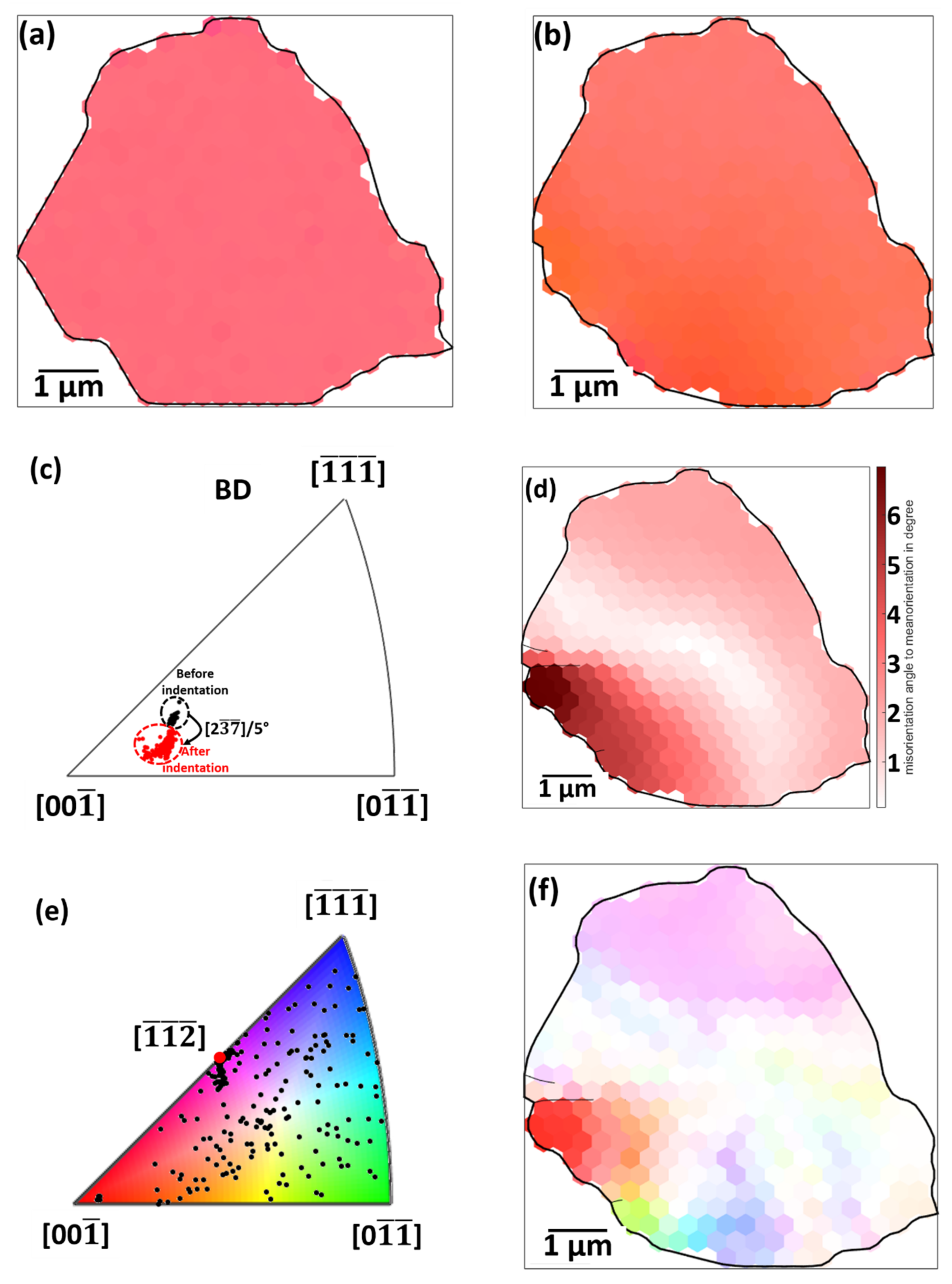
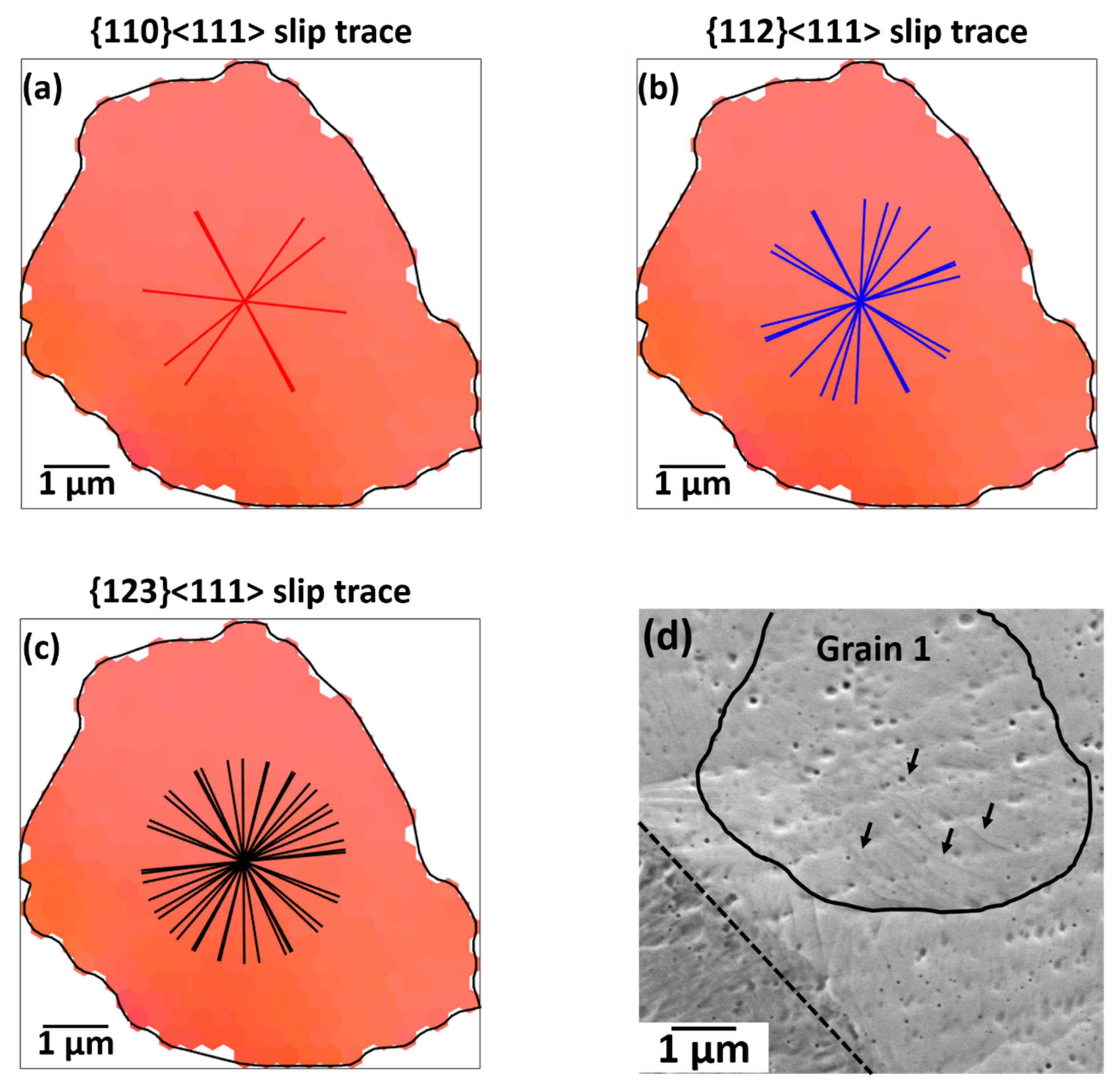
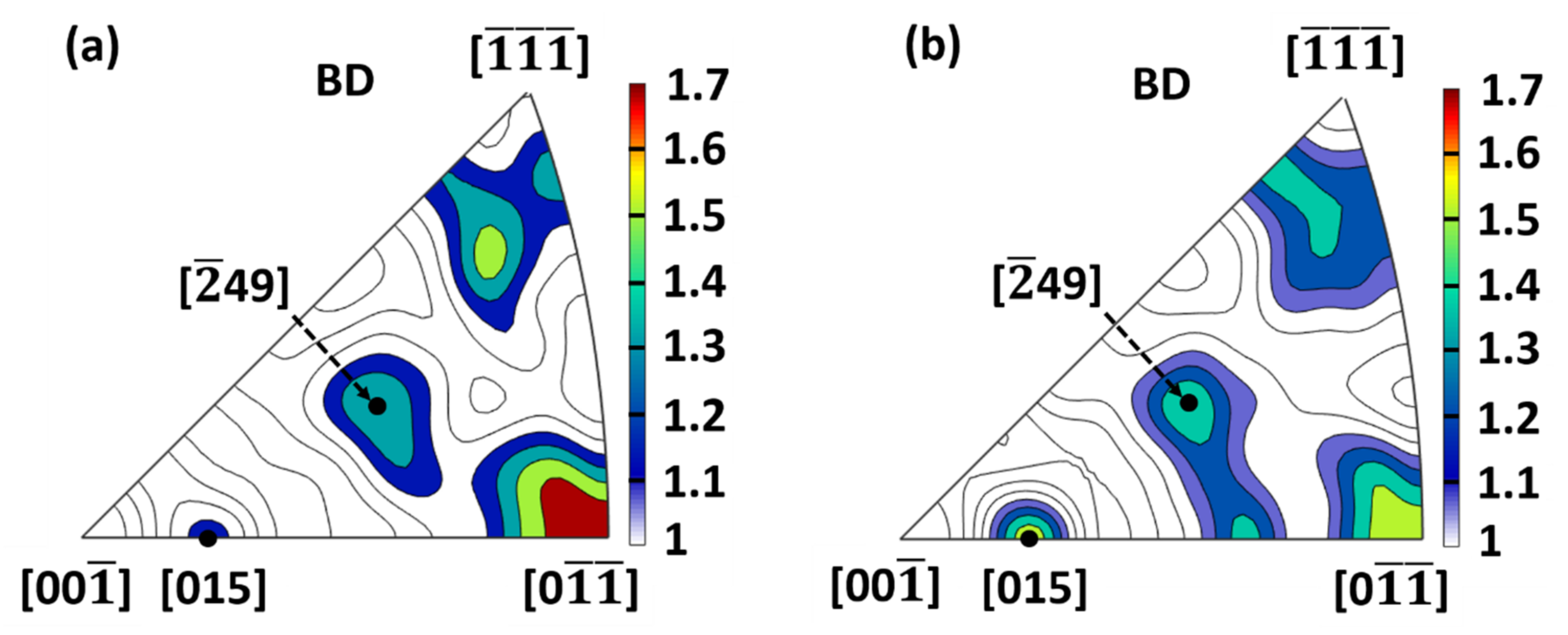
Publisher’s Note: MDPI stays neutral with regard to jurisdictional claims in published maps and institutional affiliations. |
© 2022 by the authors. Licensee MDPI, Basel, Switzerland. This article is an open access article distributed under the terms and conditions of the Creative Commons Attribution (CC BY) license (https://creativecommons.org/licenses/by/4.0/).
Share and Cite
Pramanik, S.; Tasche, F.; Hoyer, K.-P.; Schaper, M. Orientation-Dependent Indentation Behaviour of Additively Manufactured FeCo Sample: A Quasi In-Situ Study. Magnetism 2022, 2, 88-104. https://doi.org/10.3390/magnetism2020007
Pramanik S, Tasche F, Hoyer K-P, Schaper M. Orientation-Dependent Indentation Behaviour of Additively Manufactured FeCo Sample: A Quasi In-Situ Study. Magnetism. 2022; 2(2):88-104. https://doi.org/10.3390/magnetism2020007
Chicago/Turabian StylePramanik, Sudipta, Frederik Tasche, Kay-Peter Hoyer, and Mirko Schaper. 2022. "Orientation-Dependent Indentation Behaviour of Additively Manufactured FeCo Sample: A Quasi In-Situ Study" Magnetism 2, no. 2: 88-104. https://doi.org/10.3390/magnetism2020007






